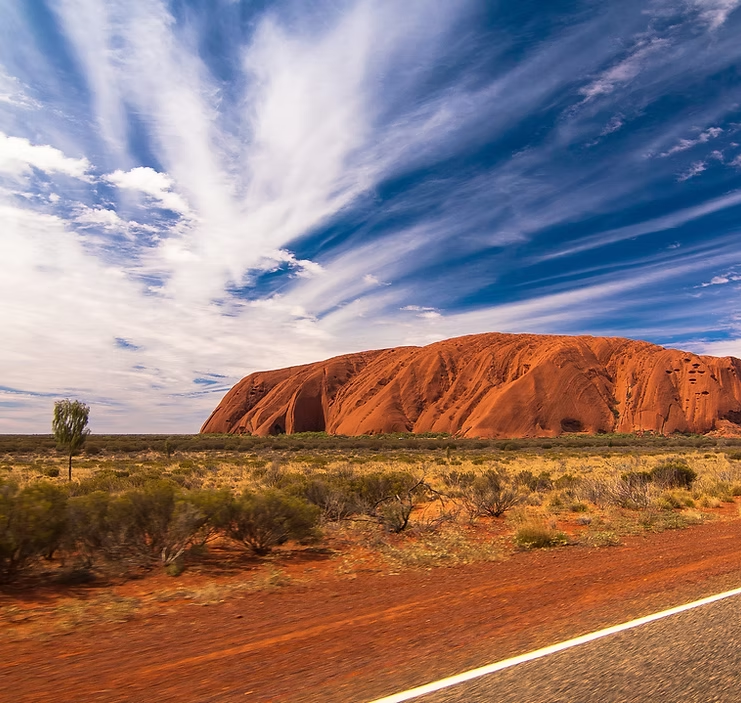
Uluru-Kata Tjuta
Uluru-Kata Tjuta
Uluru-Kata Tjuta: Australia’s Spiritual Heartland
Uluru-Kata Tjuta National Park is one of Australia’s most iconic and sacred landscapes, home to the majestic Uluru (Ayers Rock) and the striking Kata Tjuta (The Olgas). This UNESCO World Heritage site is deeply significant to the Anangu people, the traditional custodians of the land. Visitors can witness breathtaking sunrises and sunsets over the red rock formations, learn about Aboriginal culture, and explore the rugged desert landscape. Whether you’re walking around Uluru’s base, marveling at the domes of Kata Tjuta, or stargazing under the vast Outback sky, Uluru-Kata Tjuta is a must-visit destination for those seeking a deep connection with Australia’s natural and cultural heritage.
Learn More
Frequently Asked Questions: Uluru-Kata Tjuta
Uluru-Kata Tjuta experiences extreme desert temperatures, so planning your visit at the right time is important:
- May to September (Cool Season): Best time to visit – mild temperatures, clear skies, and ideal for hiking.
- October to April (Hot Season): Very hot (can exceed 40°C / 104°F), but sunrises, sunsets, and stargazing are spectacular.
- December to February (Summer): Avoid long hikes due to extreme heat, but it’s a great time for seeing thunderstorms and waterfalls on Uluru.
- Uluru (Ayers Rock) – A massive sandstone monolith sacred to the Anangu people, best experienced at sunrise or sunset.
- Kata Tjuta (The Olgas) – A collection of 36 domed rock formations, offering spectacular hikes and panoramic views.
- Mala Walk – A short, guided walk around Uluru’s base, rich with Aboriginal rock art and cultural history.
- Valley of the Winds Walk – One of the best hikes in the park, offering breathtaking views of Kata Tjuta.
- Field of Light – A mesmerizing art installation by Bruce Munro featuring 50,000 solar-powered lights illuminating the desert.
- Mutitjulu Waterhole – A hidden oasis at the base of Uluru, surrounded by ancient rock art and sacred stories.
- Talinguru Nyakunytjaku Lookout – The best vantage point for watching the colors of Uluru and Kata Tjuta change at sunrise and sunset.
- Cultural Centre – Learn about Anangu traditions, Dreamtime stories, and local bush foods.
- Bush Tucker – Traditional Aboriginal food, including wattleseed damper, bush tomatoes, and native fruits.
- Kangaroo & Crocodile Meat – Unique Australian delicacies available at Outback lodges and restaurants.
- Quandong Pie – A delicious tart made from native desert peaches.
- Barramundi – A popular Australian fish, often grilled or pan-seared.
- Billy Tea & Damper – Classic Outback food, best enjoyed around a campfire.
- Flights: Direct flights to Ayers Rock Airport (Yulara) from major cities like Sydney, Melbourne, and Alice Springs.
- Car Rental: Ideal for self-driving adventures, available at the airport and in Alice Springs.
- Guided Tours: Many visitors explore the area with Aboriginal-guided cultural tours or scenic bus tours.
- Campervans & 4WDs: Great for camping and exploring the Outback at your own pace.
- Visa-free entry for up to 90 days for travelers from the U.S., Canada, U.K., EU, and other eligible countries.
- Electronic Travel Authority (ETA) required for most visitors—apply online at homeaffairs.gov.au.
- Your passport must be valid for at least six months beyond your arrival date.
- The local currency is the Australian Dollar (AUD).
- ATMs and card payments are available in Yulara, the main resort area near Uluru.
- Credit cards are widely accepted, but it’s a good idea to carry some cash for markets and Indigenous art shops.
- English is the official language.
- The local Anangu people speak Pitjantjatjara and Yankunytjatjara, but English is widely understood.
- Aboriginal cultural tours often have translators or guides who explain traditions and history.
- Uluru is sacred to the Anangu people – Climbing is no longer allowed out of respect for their culture.
- Stay on marked trails – Many areas around Uluru and Kata Tjuta are sacred sites.
- Photography restrictions – Some areas of Uluru are culturally sensitive and should not be photographed.
- Respect Indigenous customs – When visiting the Cultural Centre, be mindful of Anangu traditions and storytelling protocols.
- Take only memories – Do not take rocks, sand, or anything else from the site as souvenirs.
- Restaurants & Cafés: No tipping required, but rounding up the bill or leaving 10% for great service is appreciated.
- Tour Guides & Drivers: $5–$10 AUD per person is a kind gesture.
- Hotels & Lodges: Not expected, but a small tip for exceptional service is welcomed.
- For peak season (May–September): Book 3–6 months in advance for accommodations and tours.
- For special events (Field of Light, guided cultural experiences): Book 6–12 months ahead to secure a spot.
- For car rentals and campervans: Book well in advance, especially during peak travel months.
- COVID-19 restrictions have been lifted, but always check for updates before traveling.
- Drones are strictly prohibited in Uluru-Kata Tjuta National Park.
- Extreme heat precautions – Carry plenty of water, wear a hat, and hike early in the morning.
Contact us at 281-229-0862 or admin@pointmetoparadise.com
